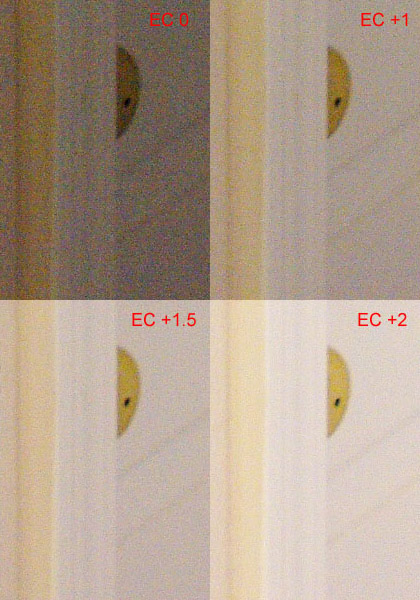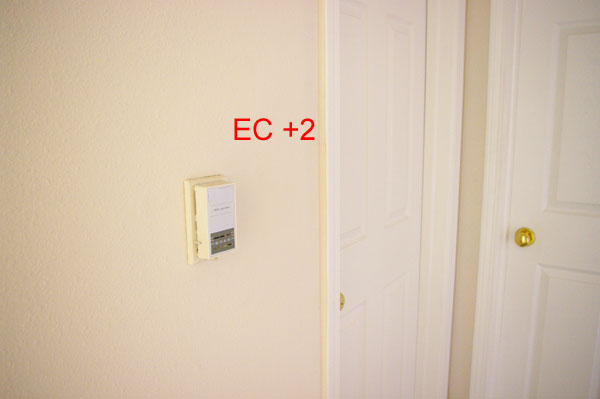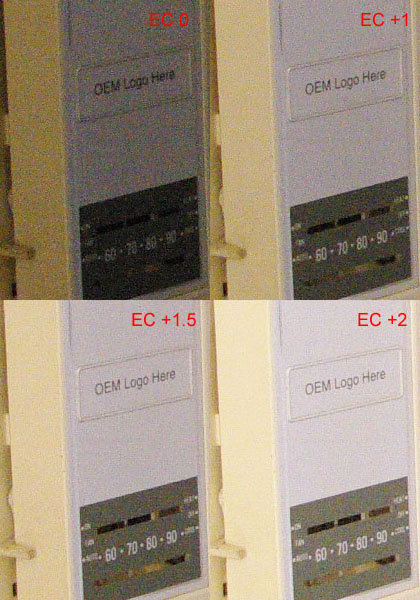– Daystar Guest Author Series –
ETTR Is Critical For High ISO Photography
Page 1, version 1.2, © 2009 by Bryan Middleton, all rights reserved.
ETTR = expose to the right, a technique first described here.
Comparing As-Metered to ETTR

Fig. 1: ISO = 3200, Exposure compensation = 0 (complete frame)

Fig. 2: ISO = 3200, Exposure compensation = +2 (complete frame)
These images were taken in my hallway. They were taken with a Pentax K20D and the 18-55mm kit lens at 18mm.
Note: so that they can be considered "serious" test images, they are as uninteresting as possible!
- 6MP, Best Quality JPG
- ISO = 3200
- High ISO Noise Reduction = Off
- Metering = Multi-Segment
- Metered Exposure = f/3.5 at 1/30
- Focus = Thermostat
- Link AF to AE = Off
- Primary light = daylight through open doorway to the right, out of frame
- Secondary light = daylight along hallway behind the camera
- White Balance = Auto
- PP = absolutely none, no auto level, no noise reduction, none
- Also = tripod, 2-sec timer, Fine Sharpness = Yes, Contrast = 2

Fig. 3: ISO = 3200, exp. comp. series, 100% crops of door

Fig. 4: ISO = 3200, exp. comp. series, 100% crops of thermostat
At the as-metered exposure, high ISO performance is not that exciting. Things look pretty grainy and both the thermostat and the cream-colored door have a bit more chroma noise than I like... The vignette area displays horrible noise. Overall, I am pretty disappointed with the high ISO performance of my camera.
Then I took a few more images. For each image, I increased Exposure Compensation (EC). By the time I have reached EC +2, my shutter speed is nowhere near 1/30 second (it will be ~1/8 second), but my image looks like I used a flash. The visible noise levels (especially that ill-looking Chroma noise) are much lower!
K10D/K20D-specific: I have the Green Button function set to Tv Shift. Each time I increase EC, the aperture will remain the same but my shutter speed will drop. I find Tv shift to be a better choice for landscapes. I want to control my aperture and slow shutter speeds can be addressed with a tripod.
Looking at the 100% crops, the difference ETTR makes in noise reduction is readily apparent. The crops of the thermostat show another benefit. As exposure is shifted to the right and visible noise is reduced, image clarity is increased. Really, this only makes sense, but I did not realize the degree of improvement until this test. At EC 0, I cannot read the settings on the thermostat. At EC +2, I can just make out the labels for Fan, Auto, Heat, etc. I have more detail right from the camera.
The EC 0 image is a bit dim. The camera's built-in meter recommended an exposure of f/3.5 at 1/30 second. This is not "wrong"; it is just the exposure that is appropriate for this scene given the limitations of the built-in meter. I could take my EC 0 image and adjust the exposure in post-processing. I could use Auto Levels, Levels, or Curves. For either method, I will reveal more noise as the shadows are brightened. My final step would be to use noise reduction software. I have not performed these manipulations with my thermostat picture, but I believe I would never see the detail of the EC +2 image. It just does not seem possible to use noise reduction on the EC 0 image and then be able to read Fan or Auto as I am able to in the EC +2 image.
ETTR can be considered the "correct" exposure for a dSLR. For any chosen aperture (either it is your maximum or what you require for depth of field), high ISO is usually used to allow faster shutter speeds. If the fastest shutter speed possible is your primary goal in using a high ISO, it may appear counter productive to use this ETTR technique. By dialing in exposure compensation, you will lower your shutter speed. However, I believe this approach is worth consideration even for sports photography. This approach will result in images that require less adjustment of levels and noise reduction in post processing. The farther you move from ETTR, the more you are cheating the correct exposure in favor of a faster shutter speed. The lighting environment and your artistic goal will determine how you balance ETTR.
My hallway is quite dim. If I were to use ISO 100 for these pictures, an equivalent exposure (including EC) would require a shutter speed of 4 seconds. Depending upon my subject, 4 seconds may not be an option. The point of this post is to illustrate that high ISO with ETTR exposure is quite usable.
I believe ETTR is critical for maximizing the dynamic range of your camera, reducing visible noise, and capturing as much detail as possible.